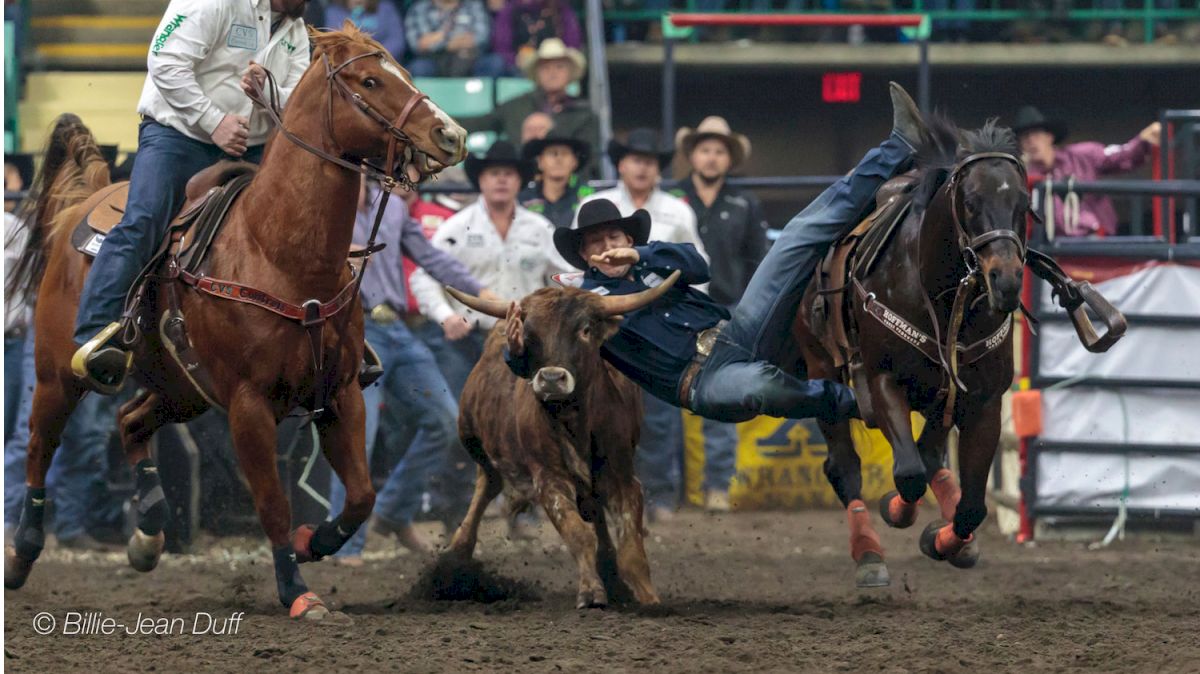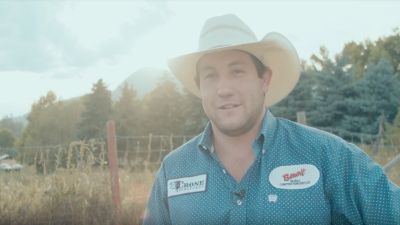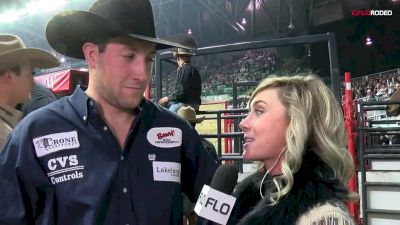Scott Guenthner: Another Shot
Scott Guenthner: Another Shot
"No matter what happens—if I don’t have a good CFR or if our baby is born during the competition—I hope I remember to enjoy myself," Scott Guenthner.

No matter what happens—if I don’t have a good CFR or if our baby is born during the competition—I hope I remember to enjoy myself. Let’s face it: I’m pretty fortunate to have another shot at the Canadian title.
by Scott Guenthner on The Cowboy Journal
Around this time last year, we were three rounds into the Canadian Finals Rodeo, and I thought, Uh, oh. This is another one of those years when I come into the Finals near the top of the standings and fall apart.
The horse I was bulldogging on just wasn’t firing out of the corner. I was having to run the steers halfway down the arena to throw them down.
After the first round, I was like, Okay, it happens. I tried fixing some things, but I got the same slow start in the second round. Before the third round I thought, I’ll try one last time with this horse. It didn’t go well.
The CFR is six rounds total, so I was halfway done and hadn’t even placed yet.
Watch the 2019 Canadian Finals Rodeo in Red Deer, Alberta LIVE on FloRodeo October 29 to November 3. Click HERE to sign up.
Becoming a Bulldogger

Winning a Canadian title in the steer wrestling had been a lifelong dream of mine. My dad, Ken, who taught me everything I know, was the Canadian bulldogging champion in 1981.
I grew up on our family’s ranch near Consort, Alberta, around 140 miles due east of Red Deer, where the CFR now takes place. I’ve ridden horses my whole life. That’s how we move the cattle.
I always wanted to be a bulldogger, like my dad, but I was a little kid, even in high school. I could walk under a volleyball net without touching my head on the bottom. I tried throwing down a few steers, but they usually shook me off, and I’d end up crashing into the back wall. I played hockey instead.
I finally had a growth spurt in grade twelve. I enrolled in Lakeland College in Alberta. Towards the end of my freshman year, I started competing in the calf roping. Around that time, Dad suggested I start bulldogging and try to win the all-around at this local amateur rodeo, one of the biggest in Canada. That gave me a goal.
By then I was six-foot-two-inches and weighed around 200 pounds, so I had the size I needed to bulldog. I started working hard at it. Dad, along with our neighbors, coached me. I practiced at our neighbor’s indoor arena. I went back to Lakeland and joined the rodeo team. I made the Canadian National College Finals Rodeo in the calf roping, team roping and steer wrestling.
I graduated in 2011 with a diploma in animal science technology. I was planning to get a diploma in agricultural business after that, but my mom, Dawn, was diagnosed with cancer that fall. She passed away in February of 2012. After that I went back to working on the ranch and rodeoing.
In 2013, I started bulldogging professionally and finished the Canadian season fourteenth in the standings—two thousand dollars short of making the CFR.
Yeah, You’re Done
In 2014, I was leading the Canadian standings in mid-July when something went wrong as I jumped a steer in Salinas, California.
Salinas is a long score. You have to see your steer and then go get him. We were running older steers that year. The one I drew was running straight down the pen. I rode up to get him. My hazer was just a tick off to the right. When I caught the steer and planted my feet, the steer stepped right, and the force tore my right pectoral muscle clean off my shoulder. I didn’t even know it at the time. I threw the steer down and made the short round.
But afterwards, I went to remove my saddle and couldn’t lift my arm above my head. The medic at the rodeo looked at me and said, You have no web, meaning the muscles that attach the shoulder to the arm and chest. They were completely gone. Yeah, you’re done, he said. You need to go home and get surgery.
I had surgery a couple weeks later, in mid-August. The doctor said my recovery would take six to nine months. I was pretty disheartened. This was my shot at winning a Canadian title. I had a healthy lead—enough that it took the other bulldoggers about four weeks to bump me out of first. But that’s how it goes. Even sitting out from July on, I finished the regular season ranked ninth. My travel partner went to the CFR in my place.
I talked to a couple of older guys, including a former world champion. Don’t rush the recovery, they said. You have a long career ahead of you.
I followed their advice and took nearly the full nine months to recover. In 2015, I came back and went into the CFR as the season leader. But the title escaped me. During each of the next two years, I went into the Canadian Finals in the top three but was never able to win the gold buckle.
Then last year happened.
Ponoka Freakout
Last year started out good and got better. In late June, it was time to go to Ponoka.
The Ponoka Stampede is my favorite rodeo of the year. The setup there is different from any other rodeo. It’s a really long score. The alley is thirty or forty feet long. They open the gate, and the steer runs, and you have to watch it and read it before you go. You’re trying to judge the speed and distance and hold your horse to score so you can get the barrier just right.
I’ve been to the National Finals Rodeo twice, and the setup at the Thomas & Mack Arena in Las Vegas is totally different. There, it’s all happening right in front of you. You nod and go. But at Ponoka, you have to see the steer run a ways before you can go. You probably run seventy feet, racing the whole time, before you jump the steer. To me, Ponoka brings it all back to being on the ranch. It’s like you’re chasing cows through the pasture so you can turn one back.
But in my years of bulldogging, I’d never even made the short round at the Ponoka Stampede—until last year.
Last year, I was second high callback in the short round. I was riding Bridger Chambers’ horse, Rooster. Bridger is my traveling partner, and I pretty much rode Rooster all year.
During my go, they opened the gate, and the steer started running. Normally, you wait, but Rooster decided he should go as soon as he saw that steer take off. A horse that’s made the run a few times at Ponoka will start to read the play. I guess that’s what Rooster did.
I pulled on the reins, and Rooster reared up. He kept lunging forward, and I kept pulling the reins. He was like a seesaw. He lunged, and I pulled. At one point, his front and back feet were off the ground—nothing touching dirt for a whole stride. He landed, and I thought, Hey, this can still work. The timing was about right, so I let him run. We caught the steer, and I threw the steer down in 4.2 seconds. It turned out to be my fastest run all week—fast enough to win the round and earn me a slot in the final four. That was pretty cool.
When I came back for the final four, I covered Rooster’s eyes in the box, so he didn’t take off early after the steer. That worked, and I ended up winning the Ponoka Stampede. I left there with about $15,000, which gave me a big boost and helped me pull even further away from the other bulldoggers. I finished the regular season in first with more than $33,000—my best run ever.
I had earned another chance—my fifth—to win the Canadian title. Could I pull it off?
Last-Minute Horse
After not placing during the first three rounds, I wasn’t so sure. Back in Red Deer, I was watching my lead slip through my fingers. They pay more than $10,000 per round at the CFR, plus nearly $16,000 for winning the average. It’s easy to see how someone could overtake my lead.
Something had to change, I thought. I need a new horse.
I asked twelve-time Canadian champion Curtis Cassidy if I could ride his horse, Tyson, last year’s Canadian Steer Wrestling Horse of the Year. There were already four guys riding Tyson, but Curtis said I was more than welcome to get on him.
That’s when things started looking up. In the fourth round, I placed second. I won the fifth round and placed second again in the sixth. Thanks to that turn-around, I placed high in the average. That gave me enough to win the gold buckle.
Winning the Canadian was a dream come true—for me and my dad.

I’m going into the CFR as the season leader again this year, though not by much. I have around $29,000 won, which is only about $2,500 ahead of Cody Cassidy. Going in as the reigning champion takes away a little pressure, but I still have eleven other guys to beat. I still have to bulldog great.
Something else has me a little on edge this year. My wife, Becky, is pregnant and due to give birth any day now. Her official due date is November 3, the last day of the CFR.
We’ve been married nearly three years. This will be our first child. Becky is real easygoing about it all. She and I talked about what would happen if she has the baby during the CFR. We have great family on both sides. Somebody will go to the hospital with her if they have to, and I’ll go run my steer and then get to the hospital as soon as I can. Sure, that scenario would be stressful, and maybe my brain wouldn’t be fully where it should be for competing, but I’m not too worried.
If we do have a baby in the middle of the CFR, I’m sure the announcers will let everyone know!
No matter what happens—if I don’t have a good CFR or if our baby is born during the competition—I will try to remember to enjoy myself. There are dozens of other guys who would love to take my spot. Lets face it: I’m pretty fortunate to have another shot at the Canadian title.
Watch the 2019 Canadian Finals Rodeo in Red Deer, Alberta LIVE on FloRodeo October 29 to November 3. Click HERE to sign up.